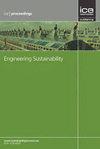水电站浮动光伏系统分析
IF 1.5
4区 工程技术
Q3 ENGINEERING, CIVIL
Proceedings of the Institution of Civil Engineers-Engineering Sustainability
Pub Date : 2024-01-29
DOI:10.1680/jensu.23.00047
引用次数: 0
摘要
与地面安装的太阳能光伏发电系统相比,浮动太阳能光伏发电(FSPV)系统可避免占用土地,实现分散式发电,是一种更具可持续性的能源选择。考虑到相关因素,本文介绍了实际水电站和模拟 FSPV 电站的概念性混合设计。本文选择了印度五座重要的水库大坝来测试所提出的设计,作为一项创新,还考虑了冷却效应。一般来说,冷却效果取决于支撑结构的类型。在这项工作中,通过考虑两种浮动结构,计算了发电量、二氧化碳(CO2)减排量、节水量和额外水力发电量等指标。结果表明,在总覆盖率小于 20% 的情况下,水力发电站水库的装机容量可增加一倍。在能量增益方面,水电站在整合浮动太阳能发电后,平均多发电 92%。此外,水电站的容量因子平均提高了 18.43%。该方案的节水总量为 1.346 亿立方米,年水力发电量增加 34.97 千兆瓦时。成本效益分析表明,快热式可再生能源发电站生产的能源最具成本效益,根据快热式可再生能源发电站平台的不同,成本效益在 2.65 至 3.05 印度卢比/千瓦时(0.03-0.04 美元/千瓦时)之间。本文章由计算机程序翻译,如有差异,请以英文原文为准。
Analysis of floating photovoltaic systems on hydro reservoirs
Floating solar photovoltaic (FSPV) systems offer a more sustainable energy option than ground-mounted ones by avoiding land use and enabling decentralised power generation. This paper presents a conceptual hybrid design for an actual hydropower plant and a simulated FSPV plant, considering relevant factors. Five significant reservoir dams in India were chosen to test the proposed design, and as a novelty, the cooling effect was considered. In general, the cooling impact is dependent on the kind of supporting structure. Metrics such as generation, carbon dioxide (CO2) reductions, water savings and extra hydropower were computed in this work by considering two kinds of floating structures. The results indicate that with a total coverage of less than 20%, the hydroelectric reservoirs can double their installed power capacity. In terms of energy gain, the hydroelectric plant generated 92% more energy on average after integrating floating solar power. Furthermore, the capacity factor of the plant grew by an average of 18.43%. The total water savings in this scenario are 134.6 million m3, resulting in an additional 34.97 GWh of annual hydroelectricity generation. The cost–benefit analysis shows that the energy produced by FSPV is the most cost effective, ranging from 2.65 to 3.05 Indian rupees/kWh (US$0.03–0.04/kWh), depending on the FSPV platform.
求助全文
通过发布文献求助,成功后即可免费获取论文全文。
去求助
来源期刊

Proceedings of the Institution of Civil Engineers-Engineering Sustainability
ENGINEERING, CIVIL-ENGINEERING, CIVIL
CiteScore
3.70
自引率
16.70%
发文量
44
审稿时长
>12 weeks
期刊介绍:
Engineering Sustainability provides a forum for sharing the latest thinking from research and practice, and increasingly is presenting the ''how to'' of engineering a resilient future. The journal features refereed papers and shorter articles relating to the pursuit and implementation of sustainability principles through engineering planning, design and application. The tensions between and integration of social, economic and environmental considerations within such schemes are of particular relevance. Methodologies for assessing sustainability, policy issues, education and corporate responsibility will also be included. The aims will be met primarily by providing papers and briefing notes (including case histories and best practice guidance) of use to decision-makers, practitioners, researchers and students.
 求助内容:
求助内容: 应助结果提醒方式:
应助结果提醒方式:


